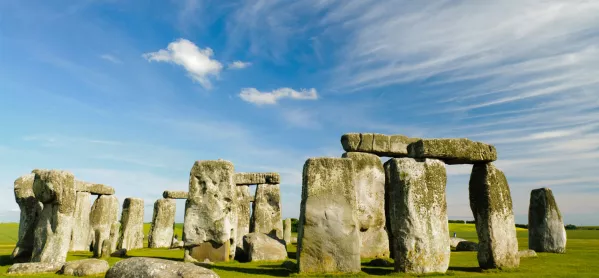10 history trips that will bring learning to life

With budgets more stretched than ever and schools under pressure to demonstrate progress in core subjects, school trips are increasingly unlikely to be high on the agenda. That said, nothing can help ignite your classes’ enthusiasm for a topic - or increase engagement in the classroom - like kick-starting your study with a unique and memorable day out.
With the input of teachers across the country, English Heritage has selected its top 10 sites for a school trip that will cover multiple subjects. With free access to any of the organisation’s sites when booked in advance, free planning visits and specially designed resources to help with risk assessments and activity ideas, budgets and planning don’t have to be a concern in creating the best possible experience for your class.
1. Stonehenge, Wiltshire
- Key stages 1-3: local history study.
- Key stage 1: significant historical events, people or places in their own locality.
- Key stage 2: changes in Britain from the Stone Age to the Iron Age.
- Key stage 3: the study of a site dating from a period before 1066 that is significant in the locality.
Are you currently teaching your key stage 2 students about late Neolithic hunter-gatherers and Bronze Age religion? It would be hard to find a better site to help you cover the topic than the world-famous Stonehenge, the most outstanding prehistoric monument in the British Isles.
Link learning to geography, maths and science by discussing how our ancestors might have moved and raised the stones, and cover literacy and speaking and listening skills by examining myths and legends linked to the site and asking your class to come up with their own theories about how the monument was used.
Pre-book the education room and use English Heritage’s free downloadable resources to supplement learning both before your visit and on-site. Visit www.english-heritage.org.uk/visit/places/stonehenge/schools/
2. Battle Abbey, East Sussex
- Key stages 1-3: local history study.
- Key stage 1: significant historical events, people or places in their own locality.
- Key stage 2: Edward the Confessor and his death in 1066.
- Key stage 3: the Norman conquest; the development of Church, state and society in medieval Britain 1066-1509; religion in daily life.
What better way to learn about 1066 and the Battle of Hastings than by walking in the footsteps of William the Conqueror and King Harold at Battle Abbey? Discover the story of 1066 by standing on the spot where the fighting took place and learn all about the events leading up to one of the most famous dates in history. The abbey remains also allow you to delve further into monastic life and the impact that William’s victory had on Britain.
3. Dover Castle, Kent
- Key stages 1-3: local history study.
- Key stage 1: significant historical events, people or places in their own locality.
- Key stage 2: the changing power of monarchs; the study of an aspect or theme in British history that extends pupils’ chronological knowledge beyond 1066.
- Key stages 2-3: enriching mathematical understanding (breaking codes in the Second World War).
- Key stage 3: the development of Church, state and society in medieval Britain 1066-1509; changes in Britain, Europe and the wider world from 1901 to the present day.
Support students’ learning in a fun and engaging way with a visit to this iconic castle, which has played an important part in history for 2,000 years, from the Roman occupation to the Second World War. Explore the secret wartime tunnels and investigate Dover Castle’s contribution during the 1939-45 conflict, including to the evacuation of Dunkirk.
Visit www.english-heritage.org.uk/visit/places/dover-castle/school-visits/
4. Osborne, Isle of Wight
- Key stages 1-3: local history study.
- Key stage 1: significant historical events, people or places in their own locality; significant changes beyond living memory; the lives of significant individuals in the past.
- Key stages 2-3: the study of an aspect or theme in British history that extends pupils’ chronological knowledge beyond 1066.
- Key stage 3: ideas, political power, industry and empire in Britain 1745-1901.
Osborne House on the Isle of Wight offers a real insight into the private lives of Queen Victoria and her family. The grounds, too, are full of treasures, including a replica Swiss Cottage with its own gardens, once tended by the royal children, and containing a museum for objects from around the world. There is also a replica grocer’s shop based on the one built for the royal children, where students can weigh out and price up chocolate and coffee for each other just as the royal family would have done. Extend learning by asking pupils to identify objects in the Swiss Cottage, discussing where they came from and how they got there. Round off your trip with a visit to the exotic Durbar room, exploring the gifts and paintings given to Queen Victoria as Empress of India.
Visit www.english-heritage.org.uk/visit/places/osborne/school-visits/
5. Kenilworth Castle, Warwickshire
- Key stages 1-3: local history study.
- Key stage 1: how people’s lives have shaped this nation and how Britain has influenced and been influenced by the wider world.
- Key stage 2: how aspects of national history are reflected in the locality; the study of a site dating from a period beyond 1066 that is significant in the locality.
- Key stage 3: the development of Church, state and society in medieval Britain 1066-1509; Europe and the wider world from 1901 to the present day.
Kenilworth Castle has been a major military stronghold, a royal palace and an inspiration to writers and artists for 900 years. A key part of its history was when Elizabeth I gifted it to her favourite, Robert Dudley, who transformed it into a palace for her delight. Help students to imagine the opulence and splendour of Elizabethan Kenilworth by walking in the Tudor queen’s footsteps in the Elizabethan garden and exploring the tower built by the Earl of Leicester to court her. Bring students’ learning up to date by investigating the property’s history and restoration in the 20th century.
Visit www.english-heritage.org.uk/visit/places/kenilworth-castle/school-visits/
6. Housesteads Roman Fort - Hadrian’s Wall, Northumberland
- Key stages 1-3: local history study.
- Key stage 1: the national and global significance of Hadrian’s Wall.
- Key stage 2: the “Romanisation” of Britain and its impact on technology, culture and beliefs.
- Key stage 3: how aspects of national history are reflected in the locality; the study of a site dating from a period before 1066 that is significant in the locality.
The Roman Empire and its impact on Britain is a key topic for primary schools, and a visit to Housesteads Roman Fort is a unique experience to help further their learning. Standing high on the wild Whin Sill escarpment, Housesteads is the most complete example of a Roman fort anywhere in Britain. With a history that goes back almost 2,000 years, Housesteads offers a great insight into what life was like for the 800 soldiers based there, and in Roman Britain more generally.
Visit www.english-heritage.org.uk/visit/places/housesteads-roman-fort-hadrians-wall/school-visits/
7. Down House, Kent
- Key stages 1-3: local history study.
- Key stage 1: working scientifically, animals and plants.
- Key stages 1-2: science, living things and their habitats.
- Key stage 2: working scientifically, evolution and inheritance.
- Key stage 3: working scientifically, biology; ideas, political power, industry and empire in Britain 1745-1901.
Down House, where Charles Darwin lived with his family from 1842 to 1882, is a site of outstanding significance with strong links to lots of different areas of curriculum study. Extend science learning via an on-site exhibition guiding visitors through Darwin’s voyage aboard the Beagle from 1831-36, his scientific discoveries and the impact of his revolutionary theories on Victorian society. At the same time, boost students’ historical knowledge by exploring the house’s authentic Victorian interiors and reflecting on the culture in which Darwin and his wife Emma raised their children.
Visit www.english-heritage.org.uk/visit/places/home-of-charles-darwin-down-house/school-visits/
8. Beeston Castle, Cheshire
- Key stages 1-3: local history study.
- Key stage 1: how people’s lives have shaped this nation and how Britain has influenced and been influenced by the wider world.
- Key stage 2: how aspects of national history are reflected in the locality; the study of a site dating from a period beyond 1066 that is significant in the locality.
- Key stage 3: the development of Church, state and society in medieval Britain 1066-1509; Europe and the wider world from 1901 to the present day.
Beeston Castle, with its impressive hilltop location and natural defences, has been home to prehistoric settlers and great barons, has acted as a defence against aristocratic rivals and was even an important English Civil War stronghold. Students can gain important historical knowledge of castle life across the centuries going right back to medieval times. Outside the castle, they can go even further back in time by exploring the prehistoric landscape and visiting the museum to look at artefacts found on site.
Visit www.english-heritage.org.uk/visit/places/beeston-castle-and-woodland-park/school-visits/
9. Lullingstone Roman Villa, Kent
- Key stages 1-3: local history study; the study of the work of artists, craftspeople and designers.
- Key stage 1: significant historical events, people or places in their own locality.
- Key stage 2: the “Romanisation” of Britain and its impact on technology, culture and beliefs.
- Key stage 3: the study of an aspect or theme in British history from before 1066.
Study art and history simultaneously at Lullingstone Roman Villa. One of the most important and complete examples of its kind in Britain, it sheds light on the lives of its affluent Roman occupiers through an outstanding collection of mosaics, wall paintings and archaeological finds. Students can also take a look at the remains of an extremely rare “house church”, among the earliest evidence for Christianity in Britain, and learn how Roman craftspeople created those beautiful mosaics and paintings.
Visit www.english-heritage.org.uk/visit/places/lullingstone-roman-villa/
10. Peveril Castle, Derbyshire
- Key stages 1-3: local history study.
- Key stage 1: significant historical events, people or places in their own locality.
- Key stage 2: the study of an aspect or theme in British history that extends pupils’ chronological knowledge beyond 1066.
- Key stage 3: the development of Church, state and society in medieval Britain 1066-1509; human and physical geography.
Founded soon after 1066 by William Peverel and mentioned in the Domesday survey, this castle is one of England’s earliest Norman fortresses. The keep, which is the castle’s most striking feature and can be explored today, was built by Henry II in 1176 after the castle came into royal hands. Displays on Peveril’s role as the administrative centre of the Royal Forest of the Peak hunting preserve will give students further insight into medieval life.
Visit www.english-heritage.org.uk/visit/places/peveril-castle/school-visits/
To plan your trip and for more information on ways to learn with English Heritage visit www.english-heritage.org.uk/learn/school-visits/
